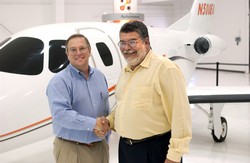The system centre.
“Our vision is deceptively simple – that on-demand air transport between secondary markets is a commercial reality for both consumers and operators,” says Iacobucci, “Some people say that this exists now, but I’d argue otherwise, because the services that currently operate are high end, and very costly to run.”
His idea was indeed simple. Before embarking on the process of setting up the conventional aspects of an airline; crew, ticketing, operations et al, he would do something that had never been done before. He would create a completely virtual business. Instead of hiring the usual management and operational teams, he took some of the $18 million of first round funding and bought himself a posse of geeks – mathematicians, demographers and complexity scientists he calls ‘ant farmers’, threw in a room full of computing power and modelled the airline in detail. Excruciating detail.
“We’ve spent the last two years testing out our market model using agent based modelling, a kind of glorified Sim City, if you will,” he explains, “It’s a technology widely used by governments and transportation agencies to model cities, but we used it to see what would and could happen in terms of travel between geographic locations. We wanted to predict the collective behaviour of business traveller communities in detail.”
This meant breaking the US down into 10×10 mile squares, while extrapolating rich demographic statistics like incomes, IRS data and the effects of marketing on travel preferences. The boffins then looked in detail at nine different classes of regular travellers from the $70,000 to $300,000 a year business executive, loaded up price and time schedules for trains and buses, as well as gas prices and driving costs at various times of the day, in fact every variable that could be added to create an elaborate model of business travel in the USA. The programs were run, tweaked and re-run again and again until these virtual travellers behaved on the computer simulation almost exactly as real travellers had actually done the year before, as taken from hard factual data the team had to hand. Once the model was tested and tuned, they could then model future scenarios, adding in the proposed Dayjet on-demand service as a live new factor.
This painstaking iterative process eventually let them accurately model 10 quarters of operation of an airline which didn’t yet exist, even down to the minutiae of managing reject rates through fare manipulation. At the same time other members of the team went out and held face to face focus groups with small and medium sized companies, executives and agencies in nine cities to pull together qualitative data to add to the mix. What’s more astonishing is that this whole two year project was not completed using massive mainframe computing power, but instead relied on twenty dual processor 3GHz Pentium personal computers hooked together in a cluster. This computer system will also be the backbone of the airline once it starts operating in earnest next year.
“We aim to continue modelling the service constantly as we go into operation,” says Iacobucci, “We’ll react to demand by adding planes and adjusting the availability of destination cities as necessary. What’s fascinating is that almost all of the new market we’re creating seems to come from the car driving traveller. What’s more, not only does our on-demand travel increase, but also scheduled flights, so air travel in general wins and the highways lose.”
This focus on technology doesn’t stop at the pre-launch work. The whole Dayjet concept rests on the shoulders of a totally automated routing and scheduling system, run on PC clusters in a couple of relatively small operation centres. The idea is that everything from the choice of pilot, aircraft and the stopovers necessary to make for the most efficient load/journey times, will be calculated and scheduled by the sophisticated software developed from this early modelling work. The technology is designed to resolve reservation requests within five seconds of the customer making an enquiry.
Iacobucci is coy about actual fare and route information – “we haven’t firmed up on all the details yet” – but is clearly pleased with the fact that the models have vindicated his concept so far. “Our whole service is based on four fundamentals. One, we will run a large fleet of small craft, it’s the granularity of small packet sizes that makes it all feasible. Two, we will only operate within constrained geographic boundaries, a kind of bounded P2P network. Three, it will be a strictly no frills service, no meals, no toilets. Finally it will be totally, 100% automated.”
Continue Reading… 1 2 3 4 5 [View All]





Wow Red, this is exciting, and much more than I expect from a blog. Not to denigrate the Journal, but is this running elsewhere? It seems to deserve more mainstream coverage.
Sounds like flying may be fun again. Soon. Coincidentally I just moved to New Mexico…
Heh, thanks Andi. No I haven’t placed it anywhere else yet, and I agree that I think it could be very interesting in the long run and so deserves more attention. Let’s see, maybe some cute Ferrety reader will pick it up….
I’ll be fascinated to see how the project goes, and hope to have another chat with Ed when he next comes over to Europe. :)